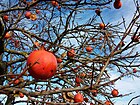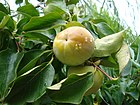Note: This is a project under development. The articles on this wiki are just being initiated and broadly incomplete. You can Help creating new pages.
Difference between revisions of "Diospyros kaki"
| Line 1: | Line 1: | ||
[[File:CDEF example fruits.jpg|thumb|right]] | [[File:CDEF example fruits.jpg|thumb|right]] | ||
| + | '''Diospyros kaki''' is an often multi-stemmed, slow-growing, deciduous tree with a fairly open, round crown. It can grow up to a height of around 27 metres. The bole is short and crooked. The tree is widely cultivated, especially in Japan and China for its edible fruit. | ||
==Uses== | ==Uses== | ||
| − | {{Uses|}}, {{Uses|}}, {{Uses|}}, {{Uses|}}, {{Uses|}}, {{Uses|}}, {{Uses|}}, {{Uses| | + | {{Uses|Diarrhoea}}, {{Uses|Bronchial complaints}}, {{Uses|Dry coughs}}, {{Uses|Constipation}}, {{Uses|Haemorrhoids}}, {{Uses|Hypertension}}, {{Uses|Coughs}}, {{Uses|Hiccups}}. |
==Parts Used== | ==Parts Used== | ||
| − | {{Parts Used|}}, {{Parts Used| | + | {{Parts Used|Fruits}}, {{Parts Used|Roasted seeds}}. |
==Chemical Composition== | ==Chemical Composition== | ||
| Line 16: | Line 17: | ||
===Dravya=== | ===Dravya=== | ||
===Rasa=== | ===Rasa=== | ||
| − | |||
===Guna=== | ===Guna=== | ||
| Line 29: | Line 29: | ||
==Habit== | ==Habit== | ||
| − | {{Habit|}} | + | {{Habit|Deciduous tree}} |
==Identification== | ==Identification== | ||
| Line 48: | Line 48: | ||
==Mode of Propagation== | ==Mode of Propagation== | ||
| − | {{Propagation|}} | + | {{Propagation|Seeds}}, {{Propagation|Cuttings of half ripewood}}. |
==How to plant/cultivate== | ==How to plant/cultivate== | ||
| − | <ref name="How to plant/cultivate"/> | + | A plant of the warm temperate and subtropical zones, it also succeeds at higher elevations up to 2,500 metres in the tropics with the trees fruiting well at lower elevations in some areas.<ref name="How to plant/cultivate"/> |
==Commonly seen growing in areas== | ==Commonly seen growing in areas== | ||
| − | {{Commonly seen| | + | {{Commonly seen|Broad leafed woodland}}. |
==Photo Gallery== | ==Photo Gallery== | ||
| Line 66: | Line 66: | ||
==References== | ==References== | ||
<references> | <references> | ||
| − | |||
<ref name="chemical composition">[Chemistry]</ref> | <ref name="chemical composition">[Chemistry]</ref> | ||
| − | |||
<ref name="Leaf">[Morphology]</ref> | <ref name="Leaf">[Morphology]</ref> | ||
| − | + | <ref name="How to plant/cultivate">[http://tropical.theferns.info/viewtropical.php?id=Diospyros+kaki Cultivation]</ref> | |
| − | <ref name="How to plant/cultivate">[Cultivation]</ref> | ||
| − | |||
</references> | </references> | ||
==External Links== | ==External Links== | ||
| − | * [ ] | + | * [https://www.cabi.org/isc/datasheet/19575 Diospyros kaki on cabi.org] |
| − | * [ ] | + | * [https://pfaf.org/user/plant.aspx?latinname=Diospyros+kaki Diospyros kaki on pfaf.org] |
| − | * [ ] | + | * [http://www.missouribotanicalgarden.org/PlantFinder/PlantFinderDetails.aspx?taxonid=243731&isprofile=0&cv=5 Diospyros kaki on missouribotanicalgarden.org] |
[[Category:Herbs]] | [[Category:Herbs]] | ||
[[Category:Pages without herbs images]] | [[Category:Pages without herbs images]] | ||
Latest revision as of 16:02, 28 April 2020
Diospyros kaki is an often multi-stemmed, slow-growing, deciduous tree with a fairly open, round crown. It can grow up to a height of around 27 metres. The bole is short and crooked. The tree is widely cultivated, especially in Japan and China for its edible fruit.
Contents
- 1 Uses
- 2 Parts Used
- 3 Chemical Composition
- 4 Common names
- 5 Properties
- 6 Habit
- 7 Identification
- 8 List of Ayurvedic medicine in which the herb is used
- 9 Where to get the saplings
- 10 Mode of Propagation
- 11 How to plant/cultivate
- 12 Commonly seen growing in areas
- 13 Photo Gallery
- 14 References
- 15 External Links
Uses
Diarrhoea, Bronchial complaints, Dry coughs, Constipation, Haemorrhoids, Hypertension, Coughs, Hiccups.
Parts Used
Chemical Composition
Common names
| Language | Common name |
|---|---|
| Kannada | |
| Hindi | |
| Malayalam | |
| Tamil | |
| Telugu | |
| Marathi | |
| Gujarathi | |
| Punjabi | |
| Kashmiri | |
| Sanskrit | |
| English |
Properties
Reference: Dravya - Substance, Rasa - Taste, Guna - Qualities, Veerya - Potency, Vipaka - Post-digesion effect, Karma - Pharmacological activity, Prabhava - Therepeutics.
Dravya
Rasa
Guna
Veerya
Vipaka
Karma
Prabhava
Habit
Identification
Leaf
| Kind | Shape | Feature |
|---|---|---|
Flower
| Type | Size | Color and composition | Stamen | More information |
|---|---|---|---|---|
| {{{5}}} |
Fruit
| Type | Size | Mass | Appearance | Seeds | More information |
|---|---|---|---|---|---|
Other features
List of Ayurvedic medicine in which the herb is used
Where to get the saplings
Mode of Propagation
Seeds, Cuttings of half ripewood.
How to plant/cultivate
A plant of the warm temperate and subtropical zones, it also succeeds at higher elevations up to 2,500 metres in the tropics with the trees fruiting well at lower elevations in some areas.[3]
Commonly seen growing in areas
Photo Gallery
References
- ↑ [Chemistry]
- ↑ [Morphology]
- ↑ Cultivation
External Links
- Ayurvedic Herbs known to be helpful to treat Diarrhoea
- Ayurvedic Herbs known to be helpful to treat Bronchial complaints
- Ayurvedic Herbs known to be helpful to treat Dry coughs
- Ayurvedic Herbs known to be helpful to treat Constipation
- Ayurvedic Herbs known to be helpful to treat Haemorrhoids
- Ayurvedic Herbs known to be helpful to treat Hypertension
- Ayurvedic Herbs known to be helpful to treat Coughs
- Ayurvedic Herbs known to be helpful to treat Hiccups
- Herbs with Fruits used in medicine
- Herbs with Roasted seeds used in medicine
- Habit - Deciduous tree
- Index of Plants which can be propagated by Seeds
- Index of Plants which can be propagated by Cuttings of half ripewood
- Herbs that are commonly seen in the region of Broad leafed woodland
- Herbs
- Pages without herbs images




